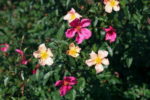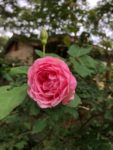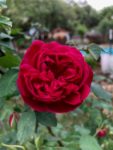Rosa sulfurea drawn by the great botanical artist Pierre-Joseph Redouté (1759-1840 )
Roses Cultivated for Over 5,000 Years
The history of the rose goes back around 5,000 years ago to China. There is fossilized evidence of the rose plant eons earlier. The Romans grew them, the English fought a war symbolizing them, (white rose of York and red rose of Lancaster.) The French Empress Josephine Bonaparte became an early collector and breeder of them at her estate, Château de Malmaison, outside of Paris.
Cultivated roses were introduced into Europe from China in the late 18th century.
Roses in North America
In early America, the indigenous people of the Pacific Northwest were growing native roses for medicinal purposes such as poultices, teas, and tonics.
When the New England colonists came to North America they found the native roses appealing. They also had brought their favorite Old Garden Roses to introduce into the New World. Eventually, rose imports from Europe traveled by ship into early American ports such as New York, Charleston and Savannah.
In 1803 Thomas Jefferson had cultivated roses in his garden at Monticello, sending native rose seeds to a friend in France.
Rose Classification System
You will find roses listed together in “classes.” Developed originally by rose nurserymen and refined by generations of rose growers, the class system is a convenient way to organize roses into groups of plants that are both similar in appearance and in need.
Old Garden Rose Classes
Rose breeders and collectors introduced more than ten thousand rose varieties between 1804 – 1935. This makes it difficult to identify older roses found growing in cemeteries, abandoned homesteads, and long-established gardens.
Species and Hybrid Species
Species roses are those grown from wild stock. Their natural range is anywhere between the Arctic Circle and just above the Equator. An local example is the Cherokee Rose, which grows naturally in several Southern states.
China Roses

Mutabilis
The original roses in this class came from China. European rose breeders then bred the plants with other classes. They were the first ever repeat-blooming roses. Their flowers have a characteristic sweet, fruity fragrance and bloom constantly. Examples: Old Blush, Ducher, Archduke Charles, Martha Gonzales, and Mutabilis.
Teas

Duchesse De Brabant
Tea roses are typically large bushes featuring blooms with a slight “tea” fragrance. These roses are found often in Southern gardens as they do well in zones 6 – 10. Many of the old gardens had several types such as Mrs. B. R. Cant, Mrs. Dudley Cross, Duchesse De Brabant and Madame Antoine Mari.
Noisettes
Hybrids of Chinas and Teas. Bred in Charleston, So. Carolina and further developed in France. Enjoying a warm climate especially zones 7 – 10. Examples: Nachitoches, Lamarque and Reve D’Or.
Bourbons

Maggie
Named for the French ruling class and again, a hybrid of Chinese and European varieties. Large and richly scented, growing to zone 9. Dr. William C. Welch from A&M University found one of the best in Louisiana, Maggie. Other examples: Souvenir de la Malmaison & Souvenir de St. Anne’s.
Modern Garden Rose Classes
Moving into more modern times, many new classes have evolved, often blending one or more of the old varieties. Hybrid Teas, Polyanthas, Floribundas, Grandifloras, Hybrid Musks, Hybrid Rugosas, and Miniatures. The list continues to grow as nurserymen and rose specialists continue their love of the rose.
Share What You Know

Founding Travis County Master Gardeners Association members Ron Miller and Don Freeman in 2004
Two wonderful, knowledgeable Master Gardeners helped me on numerous occasions learn more about roses. They shared their expertise with anyone interested and always with a smile. Now they are both gone, but certainly not forgotten by many.
Following in their footsteps, we all can learn that by sharing our gardening advice, we enrich others.
Thank you, Don Freeman and Ron Miller!
Additional Resources
Best Roses for Austin and Travis County
Roses – The Southern Garden this page is the hub for many of Dr. William Welch’s Gardening articles
The Organic Rose Garden by Liz Druitt, Taylor Trade Publishing (April 1, 1996)
Heirloom Gardening in the South by William C. Welch and Greg Grant
February Gardening Checklist for Austin and Central Texas

Carolyn Williams and her husband live and garden west of Austin in the land of limestone and caliche. This will be her 21st year as a member of Travis County Master Gardeners Association, where she has held several offices including two years as President. Carolyn has chaired numerous committees , writes articles for the TCMGA Compost Bin, gives talks to local clubs and organizations, and is a certified Landscape Designer who always enjoys discovering the beauty and rhythms of her own garden.
